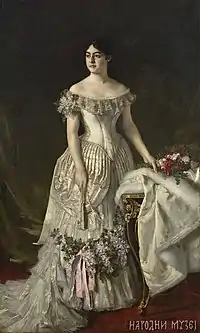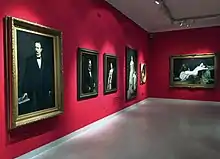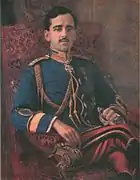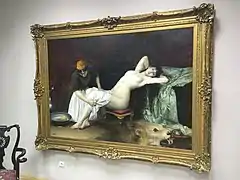Vlaho Bukovac
Vlaho Bukovac (French: Blaise Bukovac; Italian: Biagio Fagioni; 4 July 1855 – 23 April 1922) was an Austro-Hungarian painter and academic.[1][2][3][4] His life and work were eclectic, for the artist pursued his career in a variety of locales and his style changed greatly over the course of that career. He is probably best known for his 1887 nude Une fleur (A Flower), which he created during his French period and which received attention in various reviews and publications during his lifetime. Bukovac was the court painter for Obrenović dynasty, Karađorđević dynasty and Petrović-Njegoš dynasty. In Zagreb, he is probably best known as the painter of the 1895 theatre curtain in the Croatian National Theatre. Bukovac was a member of the Croatian Academy of Sciences and Arts, Serbian Academy of Sciences and Arts and Czech Academy of Sciences.
Vlaho Bukovac | |
|---|---|
 | |
| Born | Biagio Fagioni 5 July 1855 |
| Died | 23 April 1922 (aged 66) |
| Known for | Painting |
Notable work | Une fleur Natalie of Serbia Curtain for Croatian National Theatre of Zagreb Mrs. LeDoux |

Biography

Bukovac was born as Biagio Faggioni in the town of Cavtat south of Dubrovnik in Dalmatia. His father was an Italian from Genoa,[5] while his mother was of Croatian descent.[6] He received his artistic education in Paris where he was sent by the patron (Knez) Medo Pucić.[7] His small studies and sketches delighted his professor, the well-known Alexandre Cabanel, and Bukovac became a student at the prestigious École des Beaux-Arts. Dubrovnik-based Serb trader Petar Marić helped Bukovac financially during his schooling. Bukovac later painted a portrait of him and his family.[8]
Bukovac was a correspondent member of the Czech Academy of Sciences, an honorary member of Croatian Academy of Sciences and Arts(JAZU)[9] and also a member of Serbian Academy of Sciences and Arts.[10][11] He died in Prague where he studied and taught art.

Early career
Bukovac began his career in France. He painted in a "sugary" realistic style, his fashionable paintings achieved great success at the Paris Salon. During his sojourn in France, he traveled to England and the Dalmatian coast, where he was born. His travels also included voyages to the Black Sea, South (Chile and Peru), and North America. He learnt English when living in America as a teenager and, from the mid-1880s to the First World War, regularly visited England, where many of his most popular pictures were sold by the London art dealers, Vicars Bros. They included his large religious piece, Suffer the Little Children to Come to Me, and three nude subjects, The White Slave, Potiphar’s Wife and Adam and Eve.
In Britain, he painted portraits of Vicars’s clients, including his best patrons Samson Fox of Harrogate and Richard LeDoux of Liverpool. Samson Fox had bought Suffer the Little Children to Come to Me, exhibited at the Paris Salon in 1888, which was later presented to St Robert's church in Harrogate.[12]
Kingdom of Serbia

Bukovac was the court painter for Obrenović dynasty and Karađorđević dynasty.[13][14] For his potrait of Natalie of Serbia he was awarded Order of the Cross of Takovo.[15][16] He was also awarded Order of Saint Sava.[17]
Kingdom of Montenegro
Bukovac visited Kingdom of Montenegro several times and painted member of the Petrović-Njegoš dynasty and other members of the elite.[18][19]
He was awarded Order of Prince Danilo I for his work.[20]
Some of his painting are a part of the collection of Museum of Fine Arts of Montenegro.[21]
Zagreb

Bukovac became a significant representative of fine arts in Zagreb, Croatia from 1893-97, bringing with him the spirit of French art. These new directives are most evident in his landscapes. He then began using a palette of lively and lighter colors using liberated strokes, soft rendering and the introduction of light on the painting canvas. In his time in Zagreb, he became a leader at many important cultural and artistic events. He helped initiate the construction of the Art Pavilion, and organized the first artistic exhibition in the Academy Palace in 1893. Due to conflict with Izidor Kršnjavi and his great sensitivity, he withdrew to his native Cavtat where he stayed from 1898 to 1902. Upon his return to Prague he was appointed associate professor at the Academy of Fine Arts in Prague in 1903.
In 1897, Bukovac had his residence and atelier built on King Tomislav Square and founded the Croatian Society of Artists (Croatian: Društvo hrvatskih umjetnika).[9]
Pedagogy
His departure from Prague resulted in a complete change of personality for Bukovac. He felt satisfaction and enthusiasm in Zagreb that he had not felt in a while, and began to dedicate all of his energy to his new students, one of which was noted Croatian painter Mirko Rački. It was in this time he introduced pointillism to the Prague Academy, and earned his historical reputation as an excellent pedagogue. In Zagreb, he is probably best known as the painter of the theatre curtain in the Croatian National Theatre, "The Reformation of Croatian Literature and Art" painted in 1895.[23]
Style and influences
Besides being an artist who followed the established canons dictated by the Salon and the general public, he followed his own inner impulses of artistic creation. Liberated artistic expression, which was called Impressionism, developed in the spirit of the artists who kept gathering in modernism-oriented marginal galleries in Paris in the 1870s. He knew the spirit of academism and, on the other hand, he felt the spirit of Impressionistic freedom. Having accepted modern principles, Bukovac painted casual pictures, using liberated strokes of the brush, in the pointillist technique.
Auction records
Vlaho's painting "Une fleur" sold at Bonhams in London on 14 June 2006 for £100,800.00, including the auction premium. The auction house identified the painting as Reclining Nude. It is one of his best-known paintings.
Gallery
.jpg.webp)
 Montenegran Woman
Montenegran Woman Minstrel
Minstrel Gundulić's Dream (1894)
Gundulić's Dream (1894) Deep in the Forest
Deep in the Forest Jesus, Friend of the Children
Jesus, Friend of the Children Autumn Landscape
Autumn Landscape A Little Dream
A Little Dream Long Live the King!
Long Live the King!
 Portrait of Marko Kalogjera (1880)[24]
Portrait of Marko Kalogjera (1880)[24] Velika Iza, Pavle Beljanski Memorial Collection
Velika Iza, Pavle Beljanski Memorial Collection
Sources
- Bukovac, Vlaho. Moj Život. Zagreb: Književni Jug (1918)
- Kružić-Uchytil, Vera. Vlaho Bukovac: Život i Djelo. Zagreb: Matica Hrvatska, 1968. Expanded second edition: Zagreb: Nakladni Zavod Globus (2005)
- Kružić-Uchytil, Vera. "Prvi nastupi hrvatskih umjetnika na međunarodnoj umjetničkoj sceni od 1896 do 1903 godine." Peristil 31 (1998): 193-98
- Zidić, Igor. Vlaho Bukovac. Zagreb: Moderna Galerija (2000)
- Kapičić, Anđe. Bukovac i Crna Gora. Cetinje: Matica Crnogorska (2002)
- Rossner, Rachel. "The secessionists are the Croats. They've been given their own pavilion…" Vlaho Bukovac's Battle for Croatian Autonomy at the 1896 Millennial Exhibition in Budapest', Nineteenth-Century Art Worldwide vol. 6, no.1 (2007)
Notes and references
- Searching for Blaise: Vlaho Bukovac (1855 - 1922) and his Northern Patrons, Walker Art Gallery, "He is now regarded as Croatia’s leading artist of the late 19th century. ... The Croatian artist Vlaho Bukovac (1855-1922) is well-known in Central Europe and the Balkans."
- The Southern Slav Question and the Habsburg Monarchy, Robert William Seton-Watson, 1911, pp. 140, "The first names on the roll of modern Croat artists are two Dalmatians - Vlaho Bukovac (b. 1855) and Celestine Medović (b. 1851) , both of whom have won recognition in Paris and elsewhere abroad"
- "Vlaho Bukovac". www.liverpoolmuseums.org.uk. Retrieved 2018-07-04.
- "Vlaho Bukovac House". artiststudiomuseum.org. Retrieved 2018-07-04.
- "Tko je tko i odakle: strani velikani hrvatske kulture – Nacional.hr". arhiva.nacional.hr. Retrieved 2019-01-19.
- Igor Zidic, Vlaho Bukovac (Vecernji List)
- Dimitrijević, M. "Vlaho Bukovac u Narodnom muzeju". Politika Online. Retrieved 2020-11-20.
- Spasić, Goran; Reljić, Jelica; Perišić, Miroslav (2012). Kultura Srba u Dubrovniku 1790-2010 iz riznice Srpske pravoslavne crkve Svetog blagoveštenja. Beograd: Arhiv Srbije. p. 223.
- Bukovac, Vlaho, Enciklopedija.hr
- Dimitrijević, M. "Vlaho Bukovac u Narodnom muzeju". Politika Online. Retrieved 2020-11-20.
- "Члан САНУ". web.archive.org. 2016-03-04. Retrieved 2020-11-20.
- "Vlaho Bukovac profile". National Museums Liverpool. Retrieved 10 February 2014.
- Tasić, Piše: Jelena. "Majstor portreta, originalni dekadent". Dnevni list Danas (in Serbian). Retrieved 2021-01-01.
- "Kako je hrvatski umetnik Vlaho Bukovac postao omiljeni slikar srpskih vladara". NOVA portal. 2020-12-23. Retrieved 2021-01-01.
- Petrović, Petar (2014). Slikar Vlaho Bukovac (1855-1922). Belgrade: Narodni muzej.
- "Живот је бајка - ВЛАХО БУКОВАЦ | Politikin Zabavnik". politikin-zabavnik.co.rs. Retrieved 2021-01-01.
- Димитријевић, Милица. "Прва ретроспектива Влаха Буковца у Србији". Politika Online. Retrieved 2021-01-01.
- Kapičić, Anđa (2002). Bukovac i Crna Gora. Cetinje: Matica crnogorska.
- Petrović, Jelena (2016-03-04). "Crnogorke pod bojom Vlaha Bukovca". Plava Zvijezda. Retrieved 2021-01-01.
- "Живот је бајка - ВЛАХО БУКОВАЦ | Politikin Zabavnik". politikin-zabavnik.co.rs. Retrieved 2021-01-01.
- https://www.unescomontenegro.com/images/stories/documents/vodich_EN_screen.pdf
- ""Vlaho Bukovac - Slikarstvo neprolazne lepote" - Kultura - Dnevni list Danas". www.danas.rs (in Serbian). Retrieved 2021-01-17.
- "Theatre Database / Theatre Architecture - database, projects". www.theatre-architecture.eu.
- Vera Kružić Uchytil, Vlaho Bukovac : Život i djelo (1855-1920), Nakladni zavod Globus, Zagreb, 2005, pp. 44-48, 340–341, 345–346.
External links
| Wikimedia Commons has media related to Vlaho Bukovac. |